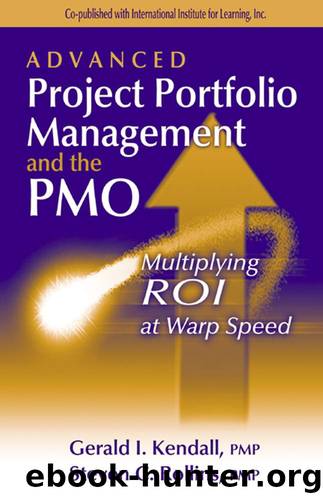Advanced Project Portfolio Management and the PMO: Multiplying ROI at Warp Speed by Kendall Gerald I. & Rollins Steve C

Author:Kendall, Gerald I. & Rollins, Steve C. [Kendall, Gerald I. & Rollins, Steve C.]
Language: eng
Format: epub
Tags: Fachbücher
ISBN: 9781932159028
Barnesnoble:
Goodreads: 287324
Publisher: J. Ross Publishing
Published: 2003-03-31T22:00:00+00:00
Figure 13.1 The Deming Workbench
their work. One way for team members to develop these skills is through a process tool known as the “Deming Workbench” (see Figure 13.1).
THE DEMING WORKBENCH
Dr. W. Edwards Deming, inventor of the Total Quality Management movement, developed the “Deming Workbench.” The Deming Workbench has many uses, but in the context of our message we are interested in how it helps team members find ways to reduce work task time while enabling them to perform their work assignments right the very first time.
The Deming Workbench breaks down into three key components. The first component consists of the input necessary to perform the process. Acceptance of the input by the process owner (work task) is dependent upon “entrance criteria.” These criteria define what is minimally acceptable. The meaning of “minimally acceptable” is anything less than these criteria will affect the process (work task) that utilizes the input.
The second component is the process application. This is where the work is actually performed. Initially the input is validated and once it has been accepted for processing, work is performed using the process guidelines and associated tools.
Upon completion of the process work, the third component, output, is produced. The produced output is validated against expected exit criteria much in the same way that input criteria were employed to protect the process effort from rework. Thus, exit criteria protect and ensure the quality of the produced output in concurrence with current process expectations and with the next process step to receive the produced output in mind.
When process owners do not recognize the changing entrance or exit criteria requirements, rework often results. Rework is a leading cause of wasted work time in project teams.
How do we prevent rework in our work assignments? This requires sufficient awareness of project-related events that occur outside the peripheral silo of the team members that might indirectly impact their work and place their delivery schedule in jeopardy and possibly the project as well.
There are three compelling points to learn.
The team must break down all barriers and look at the project completion on time and within scope as its product, not its task completion. This focuses the team on the second point.
Download
This site does not store any files on its server. We only index and link to content provided by other sites. Please contact the content providers to delete copyright contents if any and email us, we'll remove relevant links or contents immediately.
What's Done in Darkness by Kayla Perrin(25500)
Shot Through the Heart: DI Grace Fisher 2 by Isabelle Grey(18219)
Shot Through the Heart by Mercy Celeste(18160)
The Fifty Shades Trilogy & Grey by E L James(17774)
The 3rd Cycle of the Betrayed Series Collection: Extremely Controversial Historical Thrillers (Betrayed Series Boxed set) by McCray Carolyn(13189)
The Subtle Art of Not Giving a F*ck by Mark Manson(12912)
Scorched Earth by Nick Kyme(11832)
Stepbrother Stories 2 - 21 Taboo Story Collection (Brother Sister Stepbrother Stepsister Taboo Pseudo Incest Family Virgin Creampie Pregnant Forced Pregnancy Breeding) by Roxi Harding(11040)
Drei Generationen auf dem Jakobsweg by Stein Pia(10217)
Suna by Ziefle Pia(10186)
Scythe by Neal Shusterman(9262)
International Relations from the Global South; Worlds of Difference; First Edition by Arlene B. Tickner & Karen Smith(8608)
Successful Proposal Strategies for Small Businesses: Using Knowledge Management ot Win Govenment, Private Sector, and International Contracts 3rd Edition by Robert Frey(8419)
This is Going to Hurt by Adam Kay(7695)
Dirty Filthy Fix: A Fixed Trilogy Novella by Laurelin Paige(6453)
He Loves Me...KNOT by RC Boldt(5804)
How to Make Love to a Negro Without Getting Tired by Dany LaFerrière(5378)
Interdimensional Brothel by F4U(5304)
Thankful For Her by Alexa Riley(5161)
